Convolutional Neural Network Predictions for Unsteady Reynolds-Averaged Navier–Stokes-Based Numerical Simulations
Abstract
1. Introduction
2. Materials and Methods
2.1. Numerical Simulations
2.2. CNN Architecture
2.3. Training Parameters
2.4. CNN Inputs
3. Results
4. Conclusions
Author Contributions
Funding
Institutional Review Board Statement
Informed Consent Statement
Data Availability Statement
Acknowledgments
Conflicts of Interest
Nomenclature
| Nomenclature | Definition |
| CFD | Computational Fluid Dynamics |
| DL | Deep Learning |
| CNN | Convolutional Neural Network |
| DNN | Deep Neural Network |
| RANS | Reynolds-Averaged Navier–Stokes |
| GAN | Generative Adversarial Network |
| RNN | Recurrent Neural Network |
| LGR | Latent Geometry Representation |
| ReLU | Rectifier Linear Unit |
| Adam | Adaptative Moment Estimation |
| SDF | Signed Distance Function |
| FRC | Flow Region Channel |
| β1 | Forgetting factor for gradients |
| β2 | Forgetting factor for second moment gradients |
| D | Diameter of the circle |
| F | Body forces |
| K | Multiplying constant for the loss functions |
| Lt | Loss function |
| Pressure | |
| Fluid density | |
| Re | Reynolds number |
| Streamwise velocity | |
| Vertical velocity | |
| Inlet velocity to the domain |
References
- Anderson, J.D., Jr. Basic Philosophy of CFD. In Computational Fluids Dynamics; Springer: Rhode-Saint-Genèse, Belgium, 2009; pp. 3–15. [Google Scholar]
- Tao, J.; Sun, G. Application of deep learning based multi-fidelity surrogate model to robust aerodynamic design optimization. Aerosp. Sci. Technol. 2019, 92, 722–737. [Google Scholar] [CrossRef]
- Zhang, X.; Xie, F.; Ji, T.; Zhu, Z.; Zheng, Y. Multi-Fidelity Deep Neural Network Surrogate Model for Aerodynamic Shape Optimization. Comput. Methods Appl. Mech. Eng. 2021, 373, 113485. [Google Scholar] [CrossRef]
- Yan, X.; Zhu, J.; Kuang, M.; Wang, X. Aerodynamic Shape Optimization Using a Novel Optimizer Based on Machine Learning Techniques. Aerosp. Sci. Technol. 2019, 86, 826–835. [Google Scholar] [CrossRef]
- Hanna, B.N.; Dinh, N.T.; Youngblood, R.W.; Bolotnov, I.A. Coarse-Grid Computational Fluid Dynamic (CG-CFD) Error Prediction Using Machine Learning. arXiv 2017, arXiv:1710.09105. [Google Scholar]
- Bao, H.; Feng, J.; Dinh, N.; Zhang, H. Computationally efficient CFD prediction of bubbly flow using physics-guided deep learning. Int. J. Multiph. Flow 2020, 131, 103378. [Google Scholar] [CrossRef]
- Guo, X.; Li, W.; Iorio, F. Convolutional Neural Networks for Steady Flow Approximation. In Proceedings of the 22nd ACM SIGKDD International Conference on Knowledge Discovery and Data Mining, San Francisco, CA, USA, 13–17 August 2016; Association for Computing Machinery: New York, NY, USA, 2016; pp. 481–490. [Google Scholar]
- Ribeiro, M.D.; Rehman, A.; Ahmed, S.; Dengel, A. DeepCFD: Efficient Steady-State Laminar Flow Approximation with Deep Convolutional Neural Networks. arXiv 2020, arXiv:2004.08826. [Google Scholar]
- Kashefi, A.; Rempe, D.; Guibas, L.J. A point-cloud deep learning framework for prediction of fluid flow fields on irregular geometries. Phys. Fluids 2021, 33, 027104. [Google Scholar] [CrossRef]
- Ling, J.; Kurzawski, A.; Templeton, J. Reynolds averaged turbulence modelling using deep neural networks with embedded invariance. J. Fluid Mech. 2016, 807, 155–166. [Google Scholar] [CrossRef]
- Lee, S.; You, D. Prediction of Laminar Vortex Shedding over a Cylinder Using Deep Learning. arXiv 2017, arXiv:1712.07854. [Google Scholar]
- Liu, Y.; Lu, Y.; Wang, Y.; Sun, D.; Deng, L.; Wang, F.; Lei, Y. A CNN-based shock detection method in flow visualization. Comput. Fluids 2019, 184, 1–9. [Google Scholar] [CrossRef]
- Deng, L.; Wang, Y.; Liu, Y.; Wang, F.; Li, S.; Liu, J. A CNN-based vortex identification method. J. Vis. 2019, 22, 65–78. [Google Scholar] [CrossRef]
- Nowruzi, H.; Ghassemi, H.; Ghiasi, M. Performance predicting of 2D and 3D submerged hydrofoils using CFD and ANNs. J. Mar. Sci. Technol. 2017, 22, 710–733. [Google Scholar] [CrossRef]
- Mohan, A.; Daniel, D.; Chertkov, M.; Livescu, D. Compressed Convolutional LSTM: An Efficient Deep Learning Framework to Model High Fidelity 3D Turbulence. arXiv 2019, arXiv:1903.00033. [Google Scholar]
- Fang, R.; Sondak, D.; Protopapas, P.; Succi, S. Deep Learning for Turbulent Channel Flow. arXiv 2018, arXiv:1812.02241. [Google Scholar]
- Thuerey, N.; Weißenow, K.; Prantl, L.; Hu, X. Deep Learning Methods for Reynolds-Averaged Navier–Stokes Simulations of Airfoil Flows. AIAA J. 2020, 58, 25–36. [Google Scholar] [CrossRef]
- Abucide-Armas, A.; Portal-Porras, K.; Fernandez-Gamiz, U.; Zulueta, E.; Teso-Fz-Betoño, A. A Data Augmentation-Based Technique for Deep Learning Applied to CFD Simulations. Mathematics 2021, 9, 1843. [Google Scholar] [CrossRef]
- Portal-Porras, K.; Fernandez-Gamiz, U.; Ugarte-Anero, A.; Zulueta, E.; Zulueta, A. Alternative Artificial Neural Network Structures for Turbulent Flow Velocity Field Prediction. Mathematics 2021, 9, 1939. [Google Scholar] [CrossRef]
- Agostini, L. Exploration and prediction of fluid dynamical systems using auto-encoder technology. Phys. Fluids 2020, 32, 067103. [Google Scholar] [CrossRef]
- King, R.; Hennigh, O.; Mohan, A.; Chertkov, M. From Deep to Physics-Informed Learning of Turbulence: Diagnostics. arXiv 2018, arXiv:1810.07785. [Google Scholar]
- Gonzalez, F.J.; Balajewicz, M. Deep Convolutional Recurrent Autoencoders for Learning Low-Dimensional Feature Dynamics of Fluid Systems. arXiv 2018, arXiv:1808.01346. [Google Scholar]
- Maulik, R.; Lusch, B.; Balaprakash, P. Reduced-Order Modeling of Advection-Dominated Systems with Recurrent Neural Networks and Convolutional Autoencoders. Phys. Fluids 2021, 33, 037106. [Google Scholar] [CrossRef]
- Iaccarino, G.; Ooi, A.; Durbin, P.; Behnia, M. Reynolds averaged simulation of unsteady separated flow. Int. J. Heat Fluid Flow 2003, 24, 147–156. [Google Scholar] [CrossRef]
- Siemens Software. Available online: https://www.plm.automation.siemens.com/global/en/ (accessed on 20 November 2022).
- Osher, S.; Chakravarthy, S. Upwind schemes and boundary conditions with applications to Euler equations in general geometries. J. Comput. Phys. 1983, 50, 447–481. [Google Scholar] [CrossRef]
- Menter, F.R. Two-equation eddy-viscosity turbulence models for engineering applications. AIAA J. 1994, 32, 1598–1605. [Google Scholar] [CrossRef]
- Rajani, B.; Kandasamy, A.; Majumdar, S. Numerical simulation of laminar flow past a circular cylinder. Appl. Math. Model. 2009, 33, 1228–1247. [Google Scholar] [CrossRef]
- Rahman, M.; Karim, M.; Alim, A. Numerical investigation of unsteady flow past a circular cylinder using 2-D finite volume method. J. Nav. Arch. Mar. Eng. 1970, 4, 27–42. [Google Scholar] [CrossRef]
- Aramendia, I.; Fernandez-Gamiz, U.; Guerrero, E.Z.; Lopez-Guede, J.M.; Sancho, J. Power Control Optimization of an Underwater Piezoelectric Energy Harvester. Appl. Sci. 2018, 8, 389. [Google Scholar] [CrossRef]
- Ronneberger, O.; Fischer, P.; Brox, T. U-Net: Convolutional Networks for Biomedical Image Segmentation. In Medical Image Computing and Computer-Assisted Intervention—MICCAI 2015; Navab, N., Hornegger, J., Wells, W.M., Frangi, A.F., Eds.; Lecture Notes in Computer Science; Springer International Publishing: Cham, Switzerland, 2015; Volume 9351, pp. 234–241. [Google Scholar]
- Welcome to Python.Org. Available online: https://www.python.org/ (accessed on 20 November 2022).
- Kingma, D.P.; Ba, J. Adam: A Method for Stochastic Optimization. arXiv 2014, arXiv:1412.6980. [Google Scholar]
- Loshchilov, I.; Hutter, F. Decoupled Weight Decay Regularization. In Proceedings of the International Conference on Learning Representations, New Orleans, LA, USA, 6–9 May 2019. [Google Scholar]
- MATLAB. MathWorks. Available online: https://www.mathworks.com/products/matlab.html (accessed on 20 November 2022).
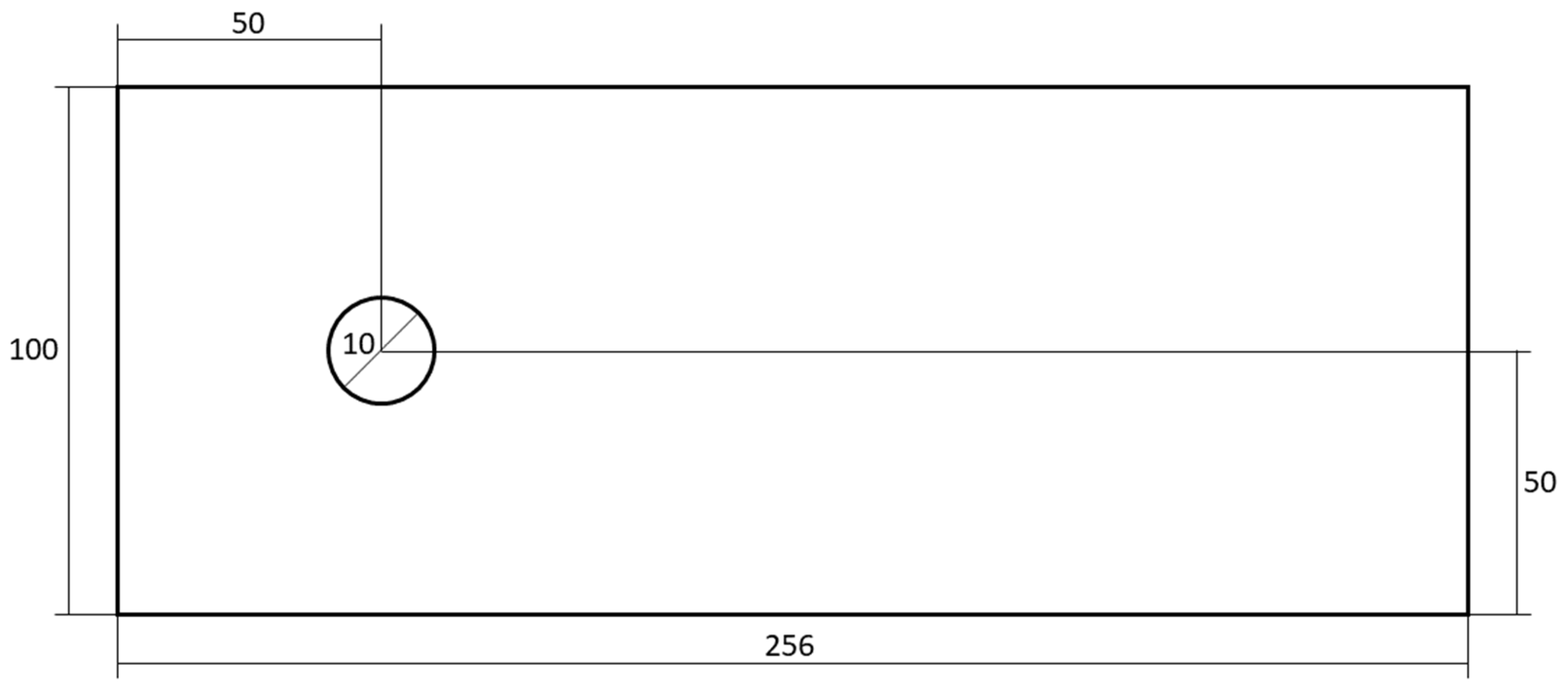
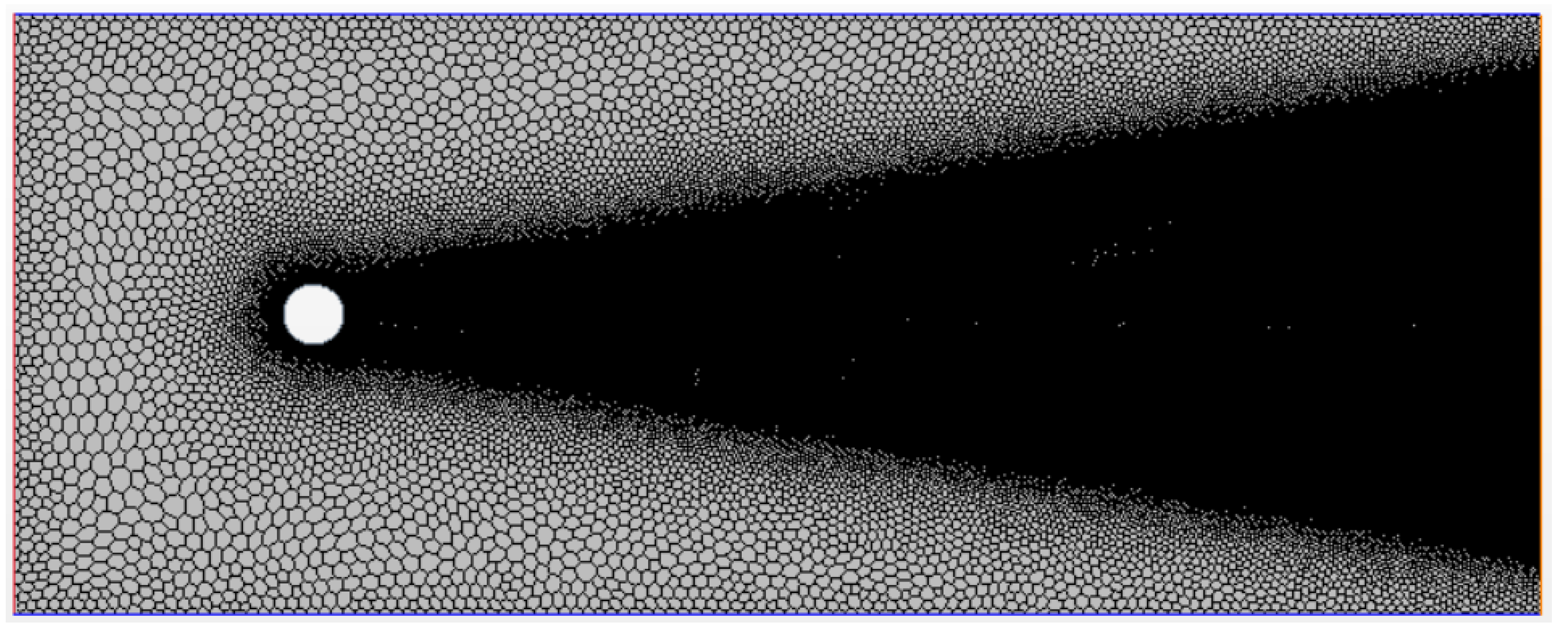
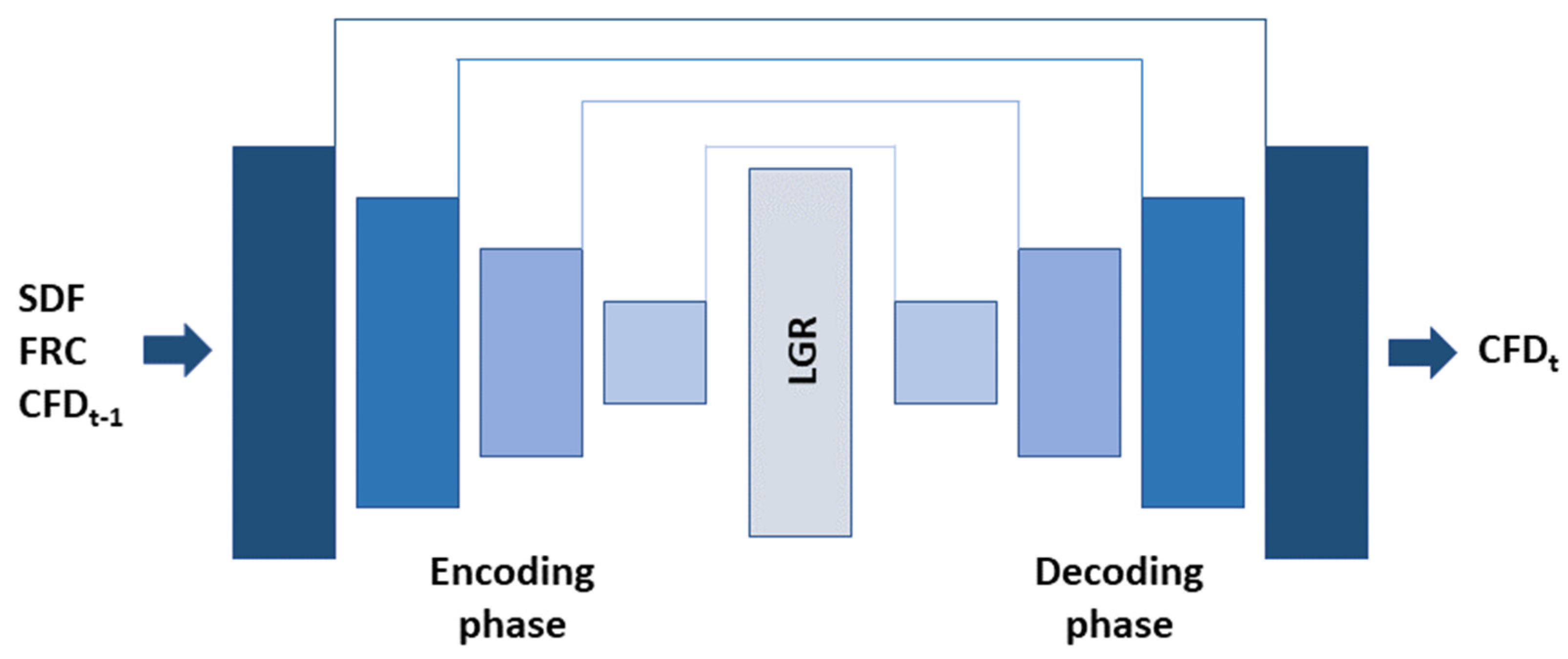

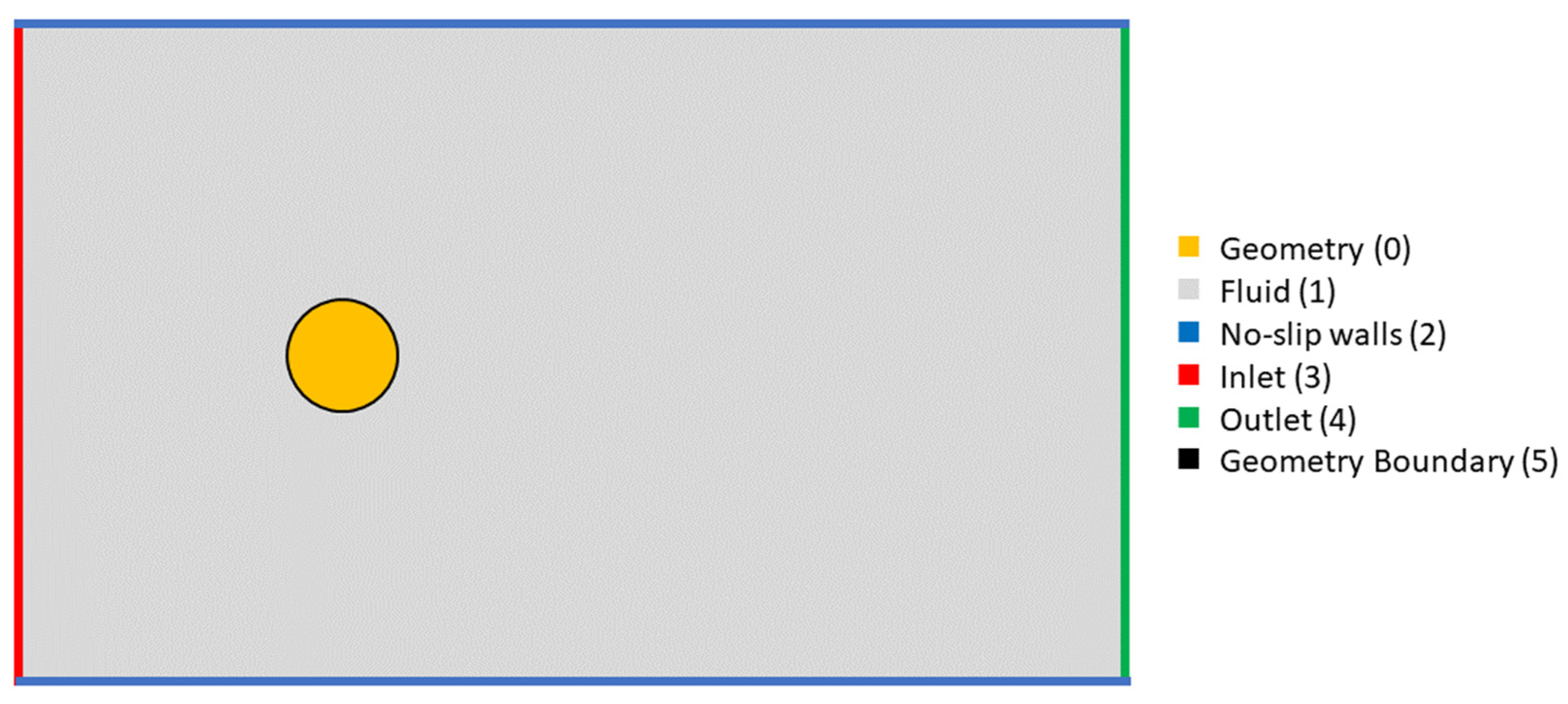
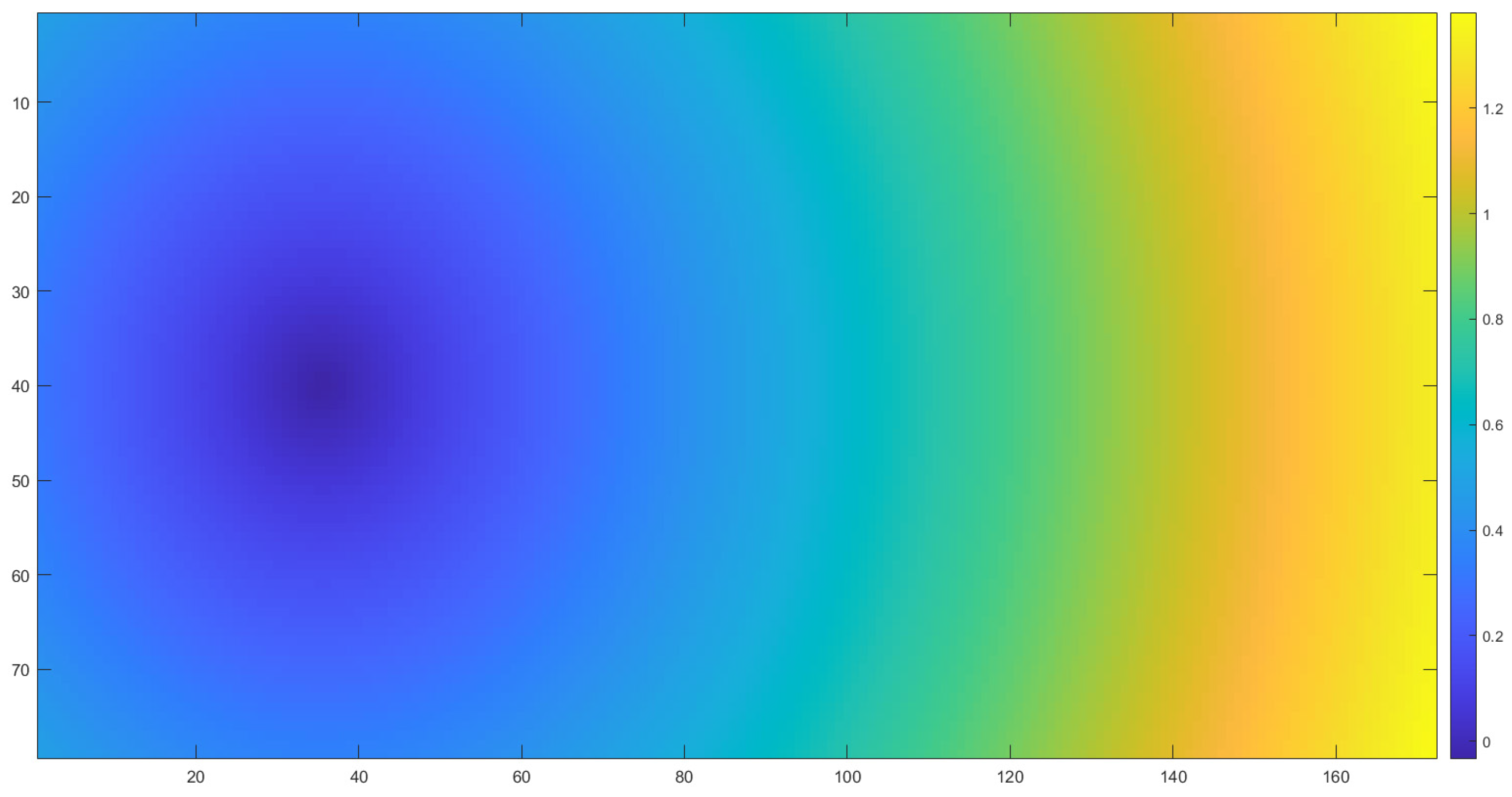
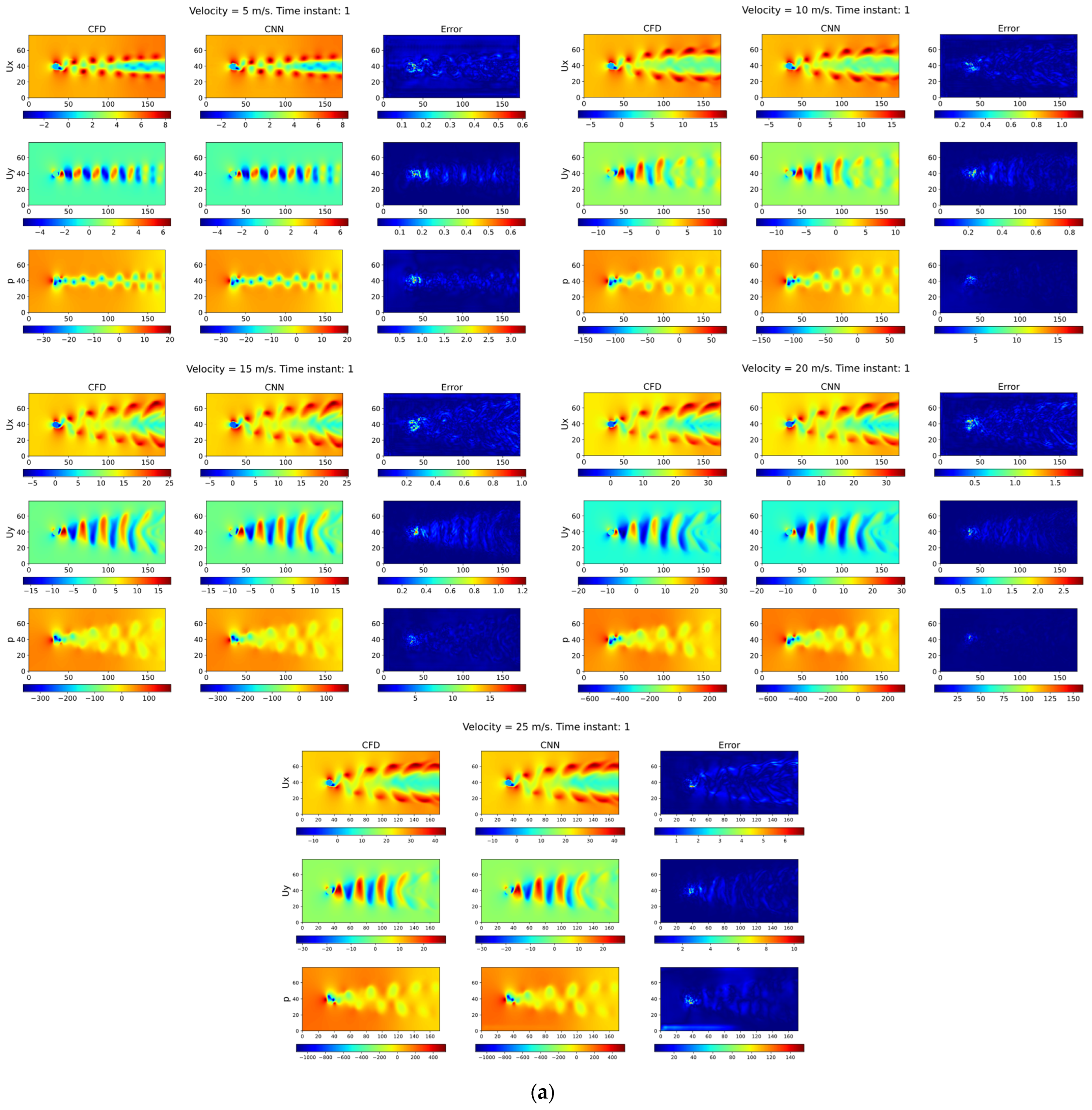
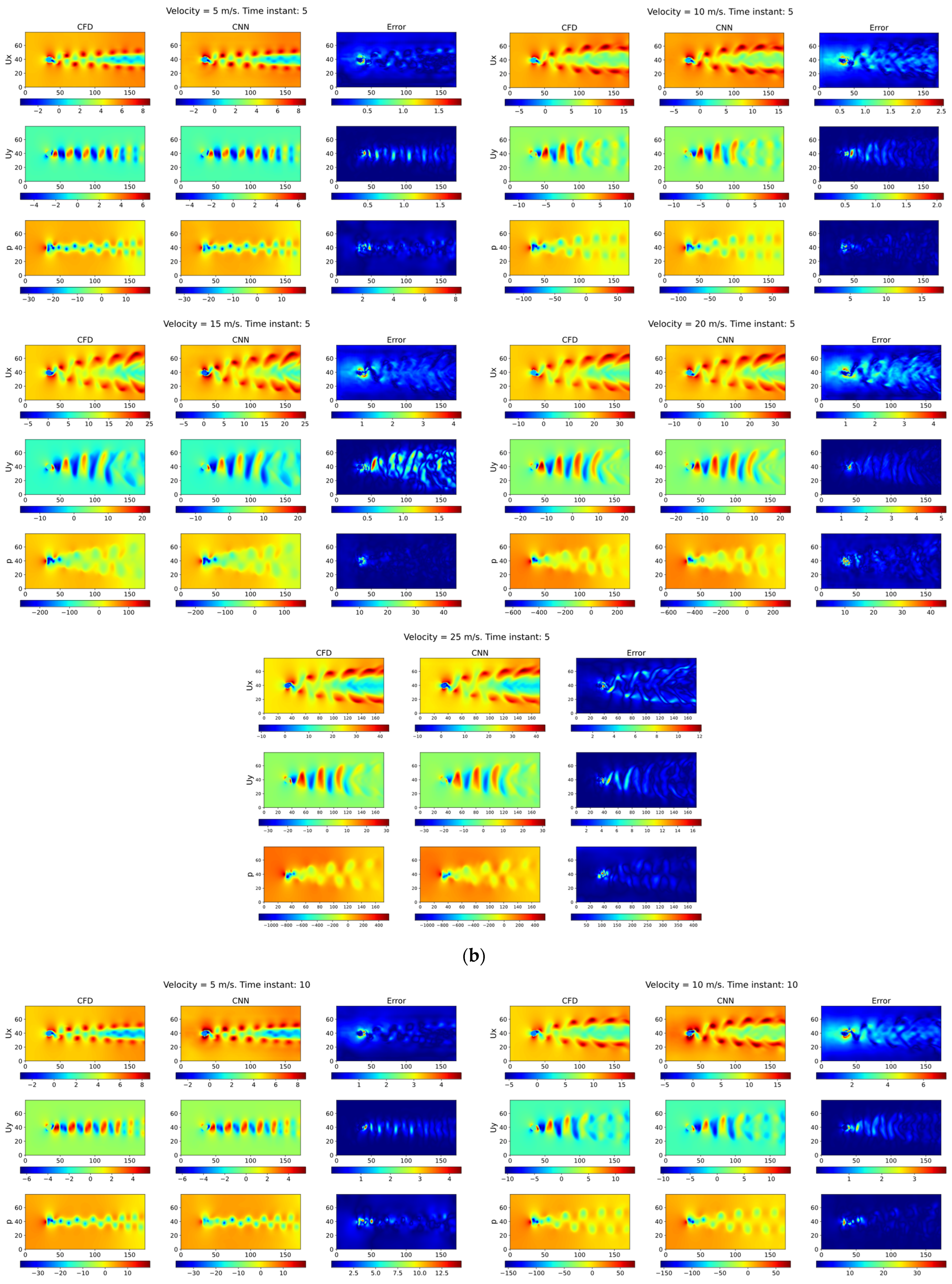
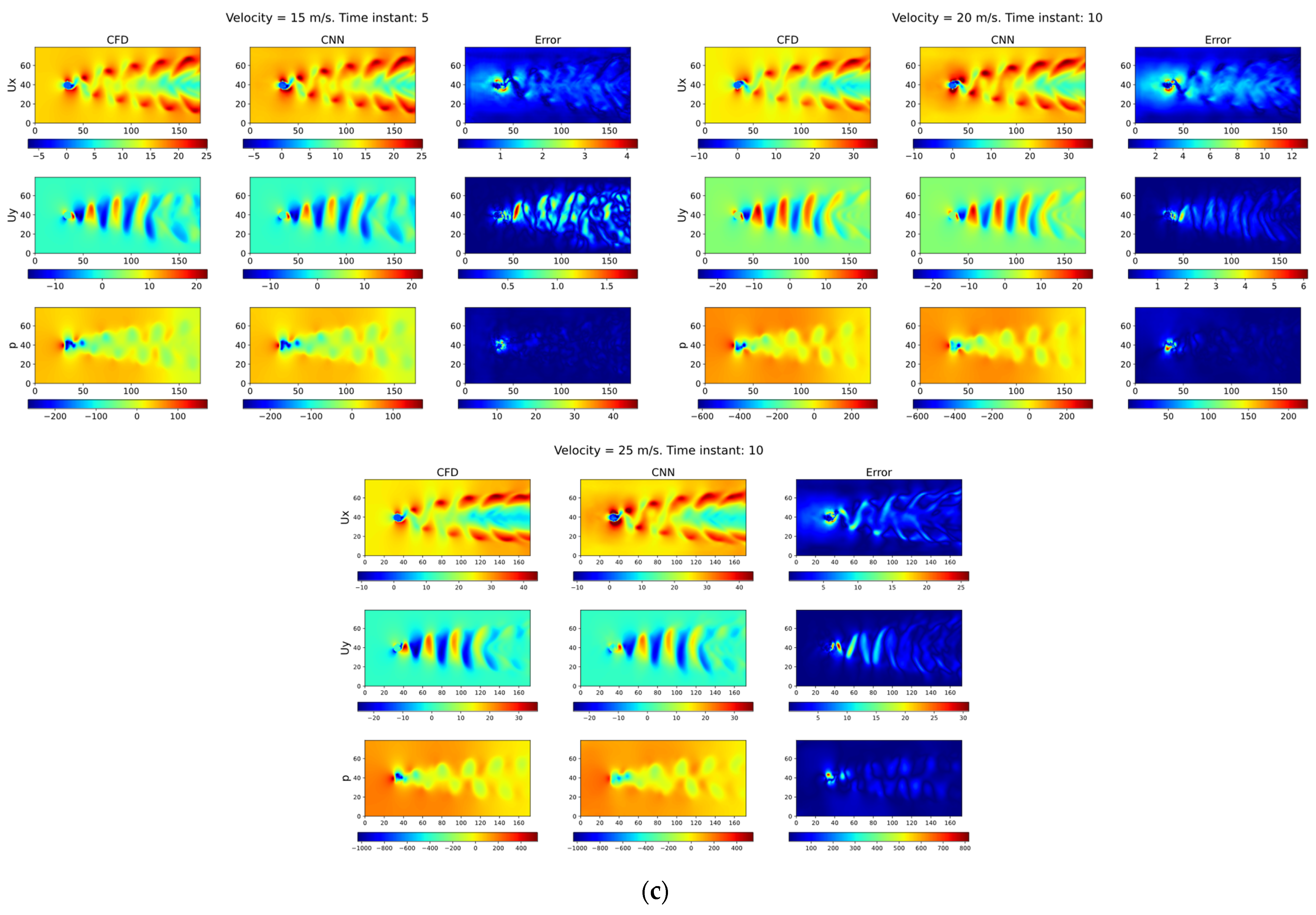
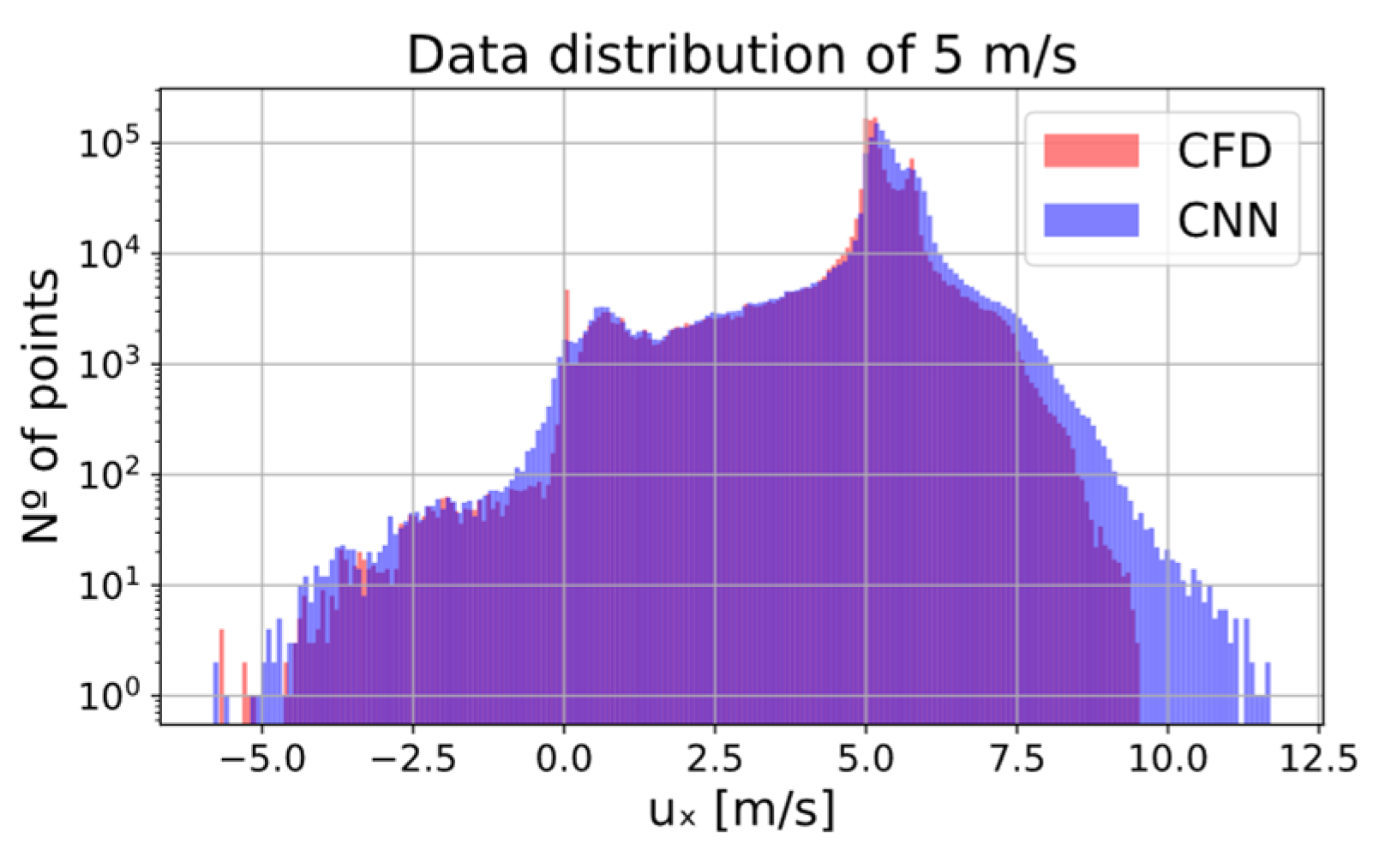
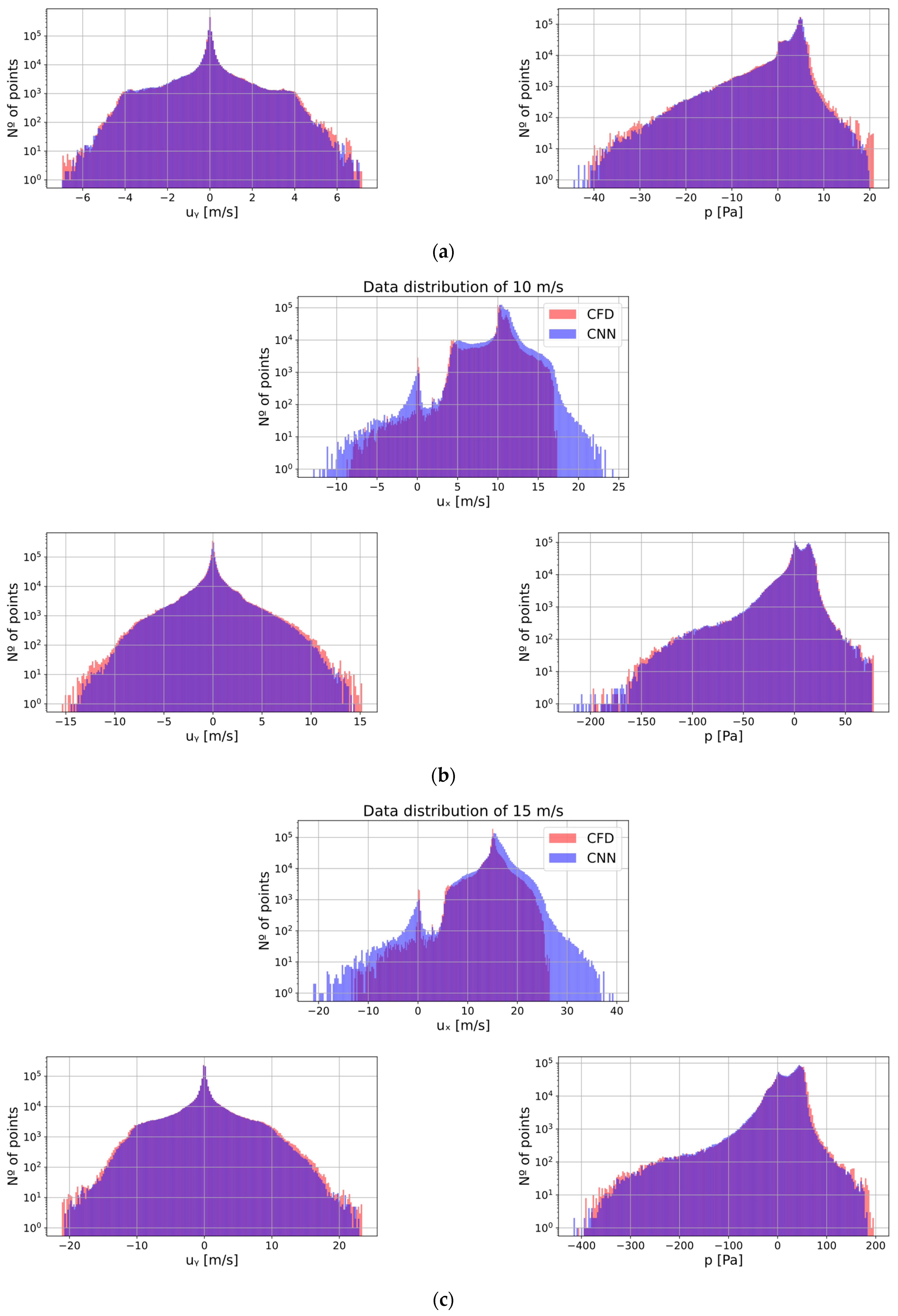

| 5 m/s | CFD | CNN | ||||
|---|---|---|---|---|---|---|
| ux | uy | p | ux | uy | p | |
| Arithmetic mean (µ) | 4.9956 | 0.0049 | 0.3990 | 5.1363 | −0.0079 | 2.8473 |
| Variance | 1.3478 | 0.9615 | 18.5783 | 1.5402 | 0.8970 | 15.7479 |
| 10 m/s | CFD | CNN | ||||
|---|---|---|---|---|---|---|
| ux | uy | p | ux | uy | p | |
| Arithmetic mean (µ) | 9.9913 | −0.0079 | 4.3280 | 10.3442 | −0.0247 | 4.4879 |
| Variance | 5.3017 | 3.4790 | 209.1635 | 5.3077 | 3.1156 | 193.8350 |
| 15 m/s | CFD | CNN | ||||
|---|---|---|---|---|---|---|
| ux | uy | p | ux | uy | p | |
| Arithmetic mean (µ) | 14.9948 | 0.0168 | 21.8190 | 15.7475 | −0.0173 | 20.1163 |
| Variance | 9.0647 | 12.9719 | 1129.4713 | 10.5008 | 11.4202 | 962.2498 |
| 20 m/s | CFD | CNN | ||||
|---|---|---|---|---|---|---|
| ux | uy | p | ux | uy | p | |
| Arithmetic mean (µ) | 19.9889 | 0.0539 | 46.7396 | 20.8735 | 0.0178 | 43.9651 |
| Variance | 21.6513 | 22.1345 | 4063.9549 | 23.2436 | 19.6142 | 3615.1444 |
| 25 m/s | CFD | CNN | ||||
|---|---|---|---|---|---|---|
| ux | uy | p | ux | uy | p | |
| Arithmetic mean (µ) | 24.9808 | 0.0329 | 72.1601 | 25.4197 | −0.1946 | 68.5239 |
| Variance | 40.7070 | 33.7651 | 11124.3126 | 37.9972 | 129.3431 | 8799.3459 |
Disclaimer/Publisher’s Note: The statements, opinions and data contained in all publications are solely those of the individual author(s) and contributor(s) and not of MDPI and/or the editor(s). MDPI and/or the editor(s) disclaim responsibility for any injury to people or property resulting from any ideas, methods, instructions or products referred to in the content. |
© 2023 by the authors. Licensee MDPI, Basel, Switzerland. This article is an open access article distributed under the terms and conditions of the Creative Commons Attribution (CC BY) license (https://creativecommons.org/licenses/by/4.0/).
Share and Cite
Abucide-Armas, A.; Portal-Porras, K.; Fernandez-Gamiz, U.; Zulueta, E.; Teso-Fz-Betoño, A. Convolutional Neural Network Predictions for Unsteady Reynolds-Averaged Navier–Stokes-Based Numerical Simulations. J. Mar. Sci. Eng. 2023, 11, 239. https://doi.org/10.3390/jmse11020239
Abucide-Armas A, Portal-Porras K, Fernandez-Gamiz U, Zulueta E, Teso-Fz-Betoño A. Convolutional Neural Network Predictions for Unsteady Reynolds-Averaged Navier–Stokes-Based Numerical Simulations. Journal of Marine Science and Engineering. 2023; 11(2):239. https://doi.org/10.3390/jmse11020239
Chicago/Turabian StyleAbucide-Armas, Alvaro, Koldo Portal-Porras, Unai Fernandez-Gamiz, Ekaitz Zulueta, and Adrian Teso-Fz-Betoño. 2023. "Convolutional Neural Network Predictions for Unsteady Reynolds-Averaged Navier–Stokes-Based Numerical Simulations" Journal of Marine Science and Engineering 11, no. 2: 239. https://doi.org/10.3390/jmse11020239
APA StyleAbucide-Armas, A., Portal-Porras, K., Fernandez-Gamiz, U., Zulueta, E., & Teso-Fz-Betoño, A. (2023). Convolutional Neural Network Predictions for Unsteady Reynolds-Averaged Navier–Stokes-Based Numerical Simulations. Journal of Marine Science and Engineering, 11(2), 239. https://doi.org/10.3390/jmse11020239






